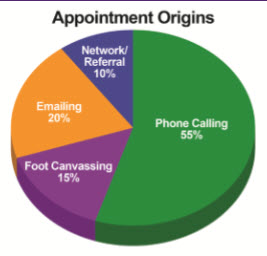
The start of every sales quarter must begin with a plan and, for most of us, that plan should include setting a sales goal to exceed last quarter’s sales. At Kingston Training Group, we know that finding new customers is an integral part of that plan. The path to success is to set yourself with a great plan and then execute that plan.
One way to measure this process is to calculate “the rate of return” on your daily tasks. It is critical to know how much you make every time you accomplish a prospecting task.
When it comes to prospecting for net-new clients, salespeople have to schedule a lot of time to make calls, send emails, foot canvass and network. Salespeople should plan on spending 12 hours a week actively prospecting. To use their time wisely, salespeople need to know not only which prospecting processes are the most successful for them, but also which activities are most enjoyable and gain the most/best results. “Metrics” can seem arduous, but if a salesperson knew he (or she) made $15 every time he made a phone call, for example, making 10 additional dials every day would be a no-brainer.
As a salesperson, the first thing to do is figure out your most successful prospecting process. If you can look at how you systemically make your meetings, you can identify your most successful process. This way, you can plan your prospecting to include all components that bring you the most success.
Your basic prospecting efforts are generally grouped into one of four functions: phone calls, foot canvassing, emailing and networking/referrals. Look back at your calendar for last year and try and figure out how you got a first-time meeting with your last 10 decision makers.
Write down how you first made positive contact with those decision makers, specify the company or contact names and the date you first made positive contact with them. Use this to identify the last 10 net-new C-level decision-maker meetings you scheduled and you will begin to see a pattern that should identify which prospecting process is most successful for you.
Next, create a breakdown for how you might allocate your prospecting time most effectively. For example, if you generated most of your meetings from phone calls, you would want to schedule most of your prospecting time for calls (see chart).
Once you have identified your most profitable prospecting process, you need to know how much money you make every time you do it. Fill the numbers below and you will know how much money you make every time you prospect.
The bottom line: 240 calls earns you a $3,000 commission; each prospecting touch point earns you $12.
Knowing what success looks like can also help a salesperson know if he is really trying hard enough. It takes at least 150 prospecting touches a week, or 30 touches a day. Quality activity has to be part of every salesperson’s equation. A salesperson should be able to execute at least 15 to 18 phone calls and corresponding emails during a 90-minute prospecting session. He should be able to schedule one live meeting for every three or four decision makers he speaks to on a call. Every 10 prospecting emails should create at least one response. A salesperson should know how long he is spending on foot canvassing and what it delivers in terms of a meeting. Most salespeople spend the majority of their prospecting efforts walking door to door. If they are not creating a meeting for every hour they spend foot canvassing, it is not the most efficient way of prospecting. All quality prospecting avenues are important and knowing which avenue is the most profitable will help the hard work pay off in opportunities and sales.
Now you know how to plan for success. Guarantee this success by executing your plan and by identifying how you make money each time you do.
Kate Kingston is president of the Kingston Training Group, which provides prospecting sales training to office technology dealerships across the country. She can be reached at kkingston@kingstontraining.com. Visit www.kingstontraining.com.